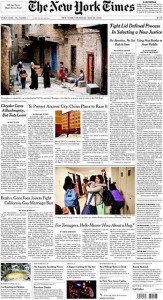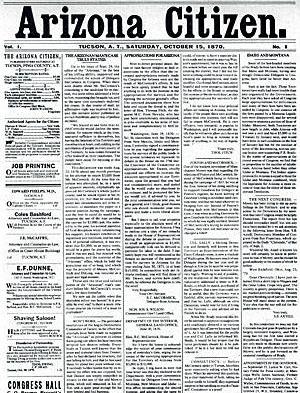Is Twitter a blessing or a curse for newsrooms? Editors are struggling with that issue in light of a recent episode in which a New York Times reporter tweeted news of the company’s discussions with Google from a supposedly confidential meeting. The Times raised eyebrows yesterday by appointing Jennifer Preston, the former editor of its regional sections, as the paper’s first social media editor. The job involves coordinating the newsroom’s use of social media, but it can also be seen as an effort to rein in reporters from sharing news before it’s been fully baked. Similar positions have recently been created by BusinessWeek , the Los Angeles Times and the Toronto Globe and Mail.
, the Los Angeles Times and the Toronto Globe and Mail.
Journalism professor Edward Wasserman tells how Matt Drudge supposedly broke the story of President Clinton’s affair with a White House intern more than a decade ago. In fact, Drudge didn’t break the story but rather related the fact that Newsweek was sitting on it. The information had been leaked to Drudge by a disgruntled Newsweek staffer, making it possibly the first example of reporters using social media channels to take publishing into their own hands.
Wasserman says the real risk of Twitter is that it will incline journalists to spend more time in front of their computer screens and less time pounding their beats. What the issue really comes down to is control. Editors are struggling with the conflicting priorities. On the one hand, they understand that tools like Twitter help satisfy readers’ needs for immediacy and transparency. On the other, they have trouble accepting the idea that reporters can now take their stories directly to the public without an editor’s approval. The Wall Street Journal recently issued guidelines for appropriate uses of social media by its staff, including the requirement that reporters gain approval before “friending” confidential sources.
The Times says that Preston won’t be a Twitter cop, but the coordinating function can involve shutting down social media just as easily as enabling it. In the end, editors will lose this battle. Media organizations have to get used to the idea of writing their first draft of history without level of fact-checking and oversight to which they are accustomed. That’s because if they don’t do it, somebody else will. This isn’t a comfortable idea, or even a good one, but it’s where the media world is headed.
Time-Spent-Reading Numbers Baffle
The latest Nielsen online reports about the amount of time people spend on newspaper websites has been released, and again the results are all over the map. A sampling of the monthly time-spent-reading figures comparing April 2008 to April 2009 (percentages approximate):
- Wall Street Journal down 40%
- Chicago Tribune up 20%
- San Francisco Chronicle up 35%
- Atlanta Journal Constitution up 90%
- Seattle Times down 60%
And on and on.
Editor & Publisher tries to sort all this out. It talks to the assistant managing editor for digital at the Minneapolis Star Tribune, whose readers spend an average of 40 minutes per month on the site. Terry Sauer tells E & P that the high numbers may be due to the placement of homepage links on individual articles, but he admits it lots of other papers do this as well.
Maybe the real issue is that time-spent-reading is a poor indicator of affinity. With more and more people using tabbed browsers, it’s possible to leave a webpage open for hours without looking at it. Also, heavy spikes of traffic prompted by local news events may actually drive down time-spent numbers because visitors come and leave so quickly. Finally, a one-month snapshot in time is virtually meaningless. Nielsen would do better to measure affinity in increments of at least six months.
Pressmen Feel the Pain
 Newspaper cutbacks are falling apart on the shoulders of pressmen, the true ink-stained wretches of the industry. Some big papers have cut back their pressroom staffs by 50% or more. Last year, the Boston Herald outsourced its print operations and cut 130 production jobs. The Boston Globe then said it would close its Billerica plant and lay off as many as 200 employees. The pressroom that printed the Seattle Post-Intelligencer and still print the Seattle Times has been whittled back from 62 to 27 employees.
Newspaper cutbacks are falling apart on the shoulders of pressmen, the true ink-stained wretches of the industry. Some big papers have cut back their pressroom staffs by 50% or more. Last year, the Boston Herald outsourced its print operations and cut 130 production jobs. The Boston Globe then said it would close its Billerica plant and lay off as many as 200 employees. The pressroom that printed the Seattle Post-Intelligencer and still print the Seattle Times has been whittled back from 62 to 27 employees.
Against that backdrop, unions representing mailers and printers at the Globe this morning agreed to concessions with the New York Times Company that chop more than $7 million in salaries and benefits. The pressmen’s meeting was described as “angry.” Unions representing editorial staff and drivers are scheduled to vote on concessions next month.
The Joy of Bankruptcy
Editor & Publisher has an excellent piece on the wonders and dangers of bankruptcy. The story is timely because many newspaper companies must face the music this year. Some people think the newspaper business is losing money, but that’s actually not true. Most major dailies still make an operating profit but their ownership is burdened with crushing debt acquired during the ill-conceived consolidation binge of a few years ago.
On the plus side, bankruptcy is a way to freeze debt payments, cancel long-term contracts and renegotiate debt, often to much lower levels. The negatives: Less flexibility to invest in anything beyond keeping the lights on, difficulty finding suppliers and the possibility that a judge could decide that the company isn’t worth saving.
That last item is the most ominous one for the industry. E & P notes that judges will permit a company to exit bankruptcy only if they believe that the company has a reasonable chance of surviving. If the judge doesn’t buy that prospect, he or she can simply shut down the operation. That hasn’t happened yet, but with organizations like Tribune Co., Sun-Times Media Group, Journal Register Co., Philadelphia Media Holdings and the Minneapolis Star Tribune already in bankruptcy and several other companies facing the prospect, the picture could take shape quickly.
Standard & Poor’s Ratings Services on Friday slashed its rating on McClatchy Co. deep into junk-bond territory after the company offered to buy back $1.15 billion in debt at just 20 cents on the dollar. McClatchy is now rated a CC borrower, which is just three steps away from a default rating.
Miscellany
Jim Hopkins, who started Gannett Blog nearly two years ago, will put it in hibernation at the end of September. Hopkins says he never intended to publish the blog longer than two or three years to begin with and that his decision was hastened by the increasingly negative tone of the roughly 4,000 comments he receives each month. The news will no doubt come as a huge relief to Gannett executives, since the blog had become a major soapbox for disgruntled employees.
The St. Louis Post-Dispatch moved circulation functions to two other newspapers owned by Lee Enterprises, cutting 39 jobs in the process.
The Huntington, W.Va. Herald-Dispatch cut 15% of its workforce, or 24 positions.
Talking Points Memo, the Web startup that has drawn attention as a possible model for new journalism, unveiled a new design that looks a lot more like a newspaper. Alexander Shaw talks about the thinking behind the new look, which moves more news “above the fold.”
And Finally…
British workers in the media, publishing and entertainment industries are the heaviest drinkers, according to the Department of Health. A survey of 1,400 people by YouGov found that media people consume an average of 44 units (presumably, 1.5-ounce drinks) a week, or almost twice the recommended maximum. The finance, insurance and real estate sectors came in second at 29 units per week.


 Once upon a time, a negative review in a major newspaper was the death knell for a new theatre production. Today, it’s an invitation for the offended party to strike back.
Once upon a time, a negative review in a major newspaper was the death knell for a new theatre production. Today, it’s an invitation for the offended party to strike back. , the Los Angeles Times and the Toronto Globe and Mail.
, the Los Angeles Times and the Toronto Globe and Mail. Newspaper cutbacks
Newspaper cutbacks 




